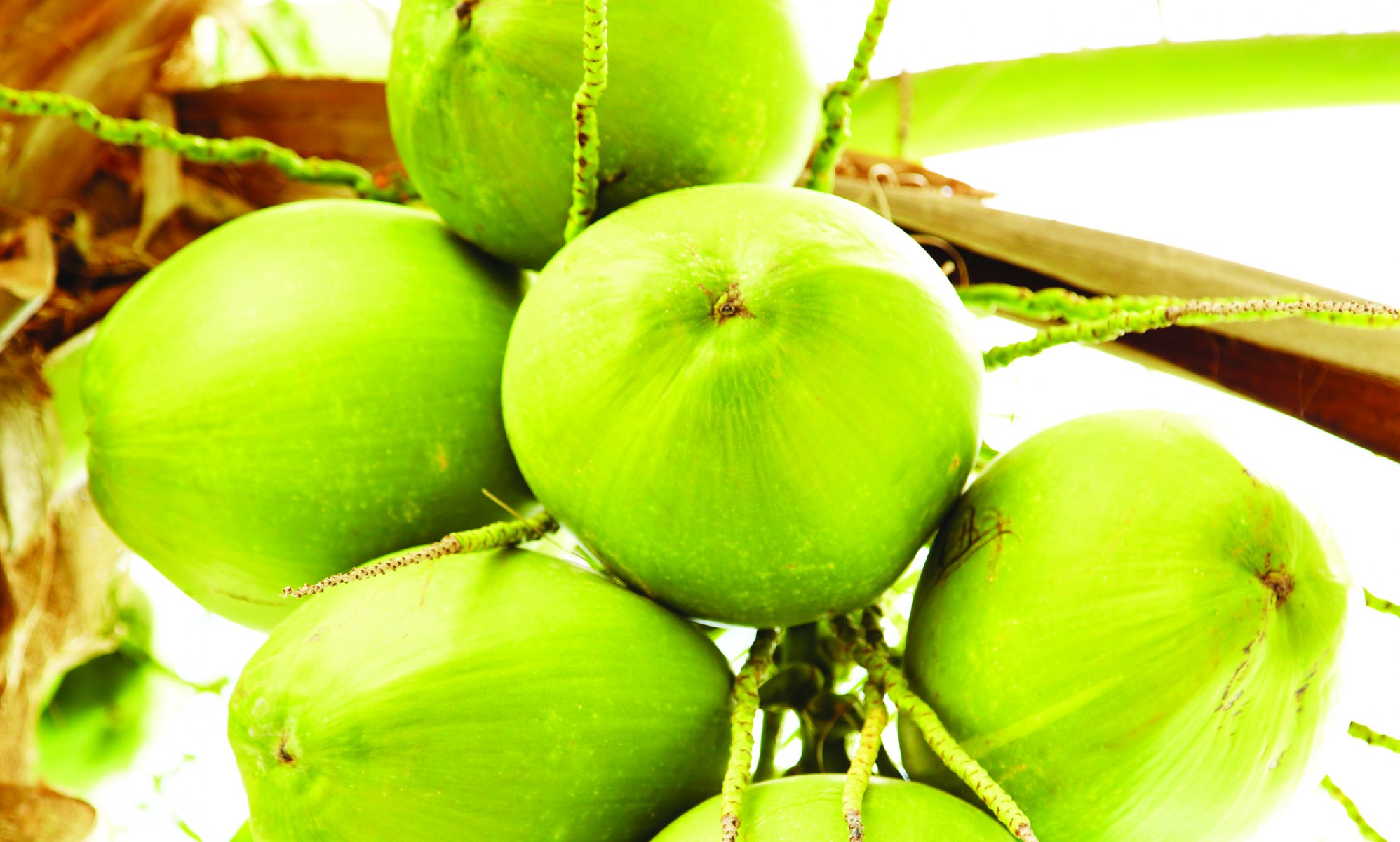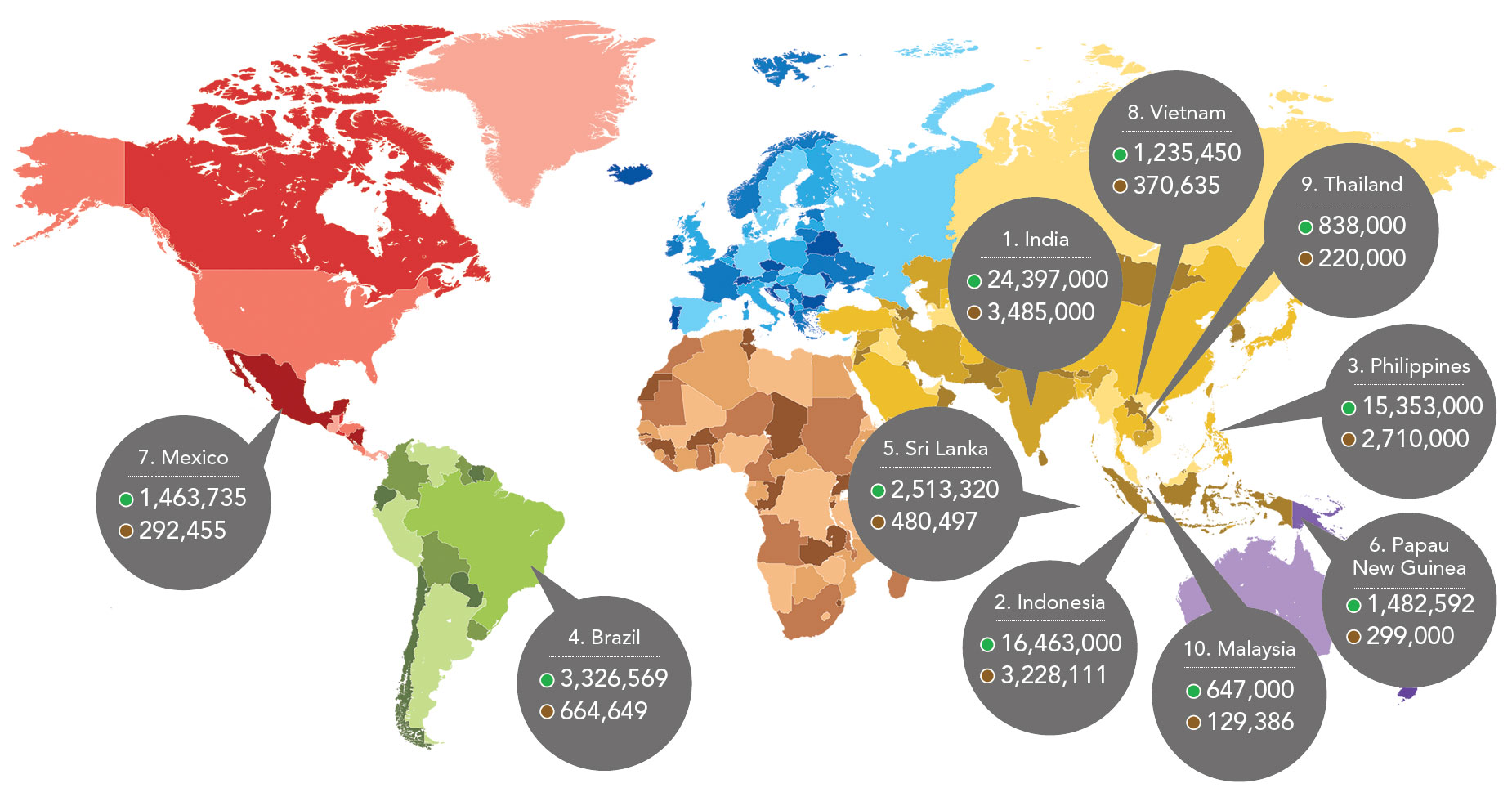Introduction

For hundreds of years, the coconut – fruit of the coconut palm (Cocos nucifera L.) – has been a great source of versatility. It provides food, drink, clothing and shelter, as well as income from its products.
Origins of the coconut
For hundreds of years, the coconut – fruit of the coconut palm (Cocos nucifera L.) – has been a great source of versatility. It provides food, drink, clothing and shelter, as well as income from its products. Due to its continuous production, the coconut is readily available all year round. Today, the main producers[fn]Source: Asian & Pacific Coconut Community & Statistical Year Book 2013[/fn] in the world are Indonesia, the Philippines and India. Each bunch of coconuts can contain between five to 12 nuts.
The coconut is a source of food, oil, coconut water, coconut milk, and medicine. It has probably been used by humans for centuries. Today, it is a common visual of dreamy relaxation and increasingly, a symbol of health. From the Asian tropics to South America, the coconut has certainly spread around the globe by waves of sea-faring people migrating and trading across continents. Light and buoyant, the coconut itself can traverse significant distances by ocean currents. It was even reported that coconuts were collected from the seas in Norway, far away from the tropics!
The versatile coconut
Break open a coconut and you will find a simple structured nut with many uses. From the flesh to water, shell and husk, each part of the coconut can become a useful object or source of nourishment.
Since the late 1980s, the coconut’s water and flesh can be turned into ready to drink (RTD) coconut beverages and ready-to-use coconut milk and cream products. Often packed into cans and cartons, these products are also increasingly available in other forms of packaging.
Coconut water
Year to date, Brazil is by far the largest market[fn]Source: Euromonitor International[/fn], with Kero Coco as the country’s leading brand of packaged coconut water. In the United States, coconut water brands such as Vita Coco, Zico, Goya and O.N.E. are the current market leaders. In Europe, consumers are gaining more awareness about coconut water’s nutritional and health benefits.
Across the globe, established brand owners of packaged coconut water are tapping into social media networks (Facebook, Twitter, Instagram) and digital marketing channels (YouTube videos, Amazon) to increase consumer awareness. Increasingly, pure coconut water and coconut water based fruit juices are seen as a lifestyle choice of the new generation across major media outlets.
Coconut milk and cream
A cooking ingredient found in many traditional Indian and Southeast Asian cuisines, coconut milk and cream is often packaged into cans and cartons for frequent consumption. Containing 14-25% fat, this staple is commonly enjoyed in sweet and savoury dishes, such as creamy chicken curries and smooth chendol desserts. To date, Indonesia and Thailand are one of the world’s largest exporters and consumers of coconut milk.
Coconut milk beverage
Leading the market for packaged coconut milk beverages is China. Yeshu is the country’s leading brand to date. With less than 1-2% fat content, coconut milk beverages are also fast becoming low fat contenders of soya and almond milk products in the United States and Europe.
Increasingly perceived as a suitable dietary substitute for lactose intolerant consumers, brands like So Delicious, Silk, Alpro and Vitasoy are already diversifying their beverage offerings to include coconut milk. Many are also highlighting the healthy composition of coconut milk oil, which consists of medium chain triglycerides, better known as the next breakthrough treatment for dementia (Alzheimer’s disease)[fn]Source: Use of medium chain triglycerides for the treatment and prevention of Alzheimer’s disease and other diseases resulting from reduced neuronal metabolism II - US patent[/fn].
Like coconut water, established brand owners of packaged coconut milk beverages are tapping into social media networks and digital marketing channels to increase global consumer demand.
Coconut production
Several economies around the world are heavily dependent on the production of copra - the dried kernel of a coconut used to extract coconut oil.
In 2013, it was estimated that the global production of coconuts was 73,811,551,000 coconuts or 2,896,709 MT in copra equivalent. Coconuts from Asia, Central and South Americas, as well as the Pacific islands make up 97.3% of the global production.
Under suitable climate, rainfall and environmental conditions, coconuts can germinate and grow into coconut palms and start fruiting after three years. Commercially, coconut palms are planted in different densities per hectare of land. In general, each hectare of land can plant more dwarf coconut palms with smaller fronds than tall coconut palms. More details of coconut plantation practices are covered in Chapter 4.
Production of Coconuts in Whole Nuts (1000 nuts) and Copra Equivalent (MT)
Source: Asian & Pacific Coconut Community Statistical Yearbook 2013


